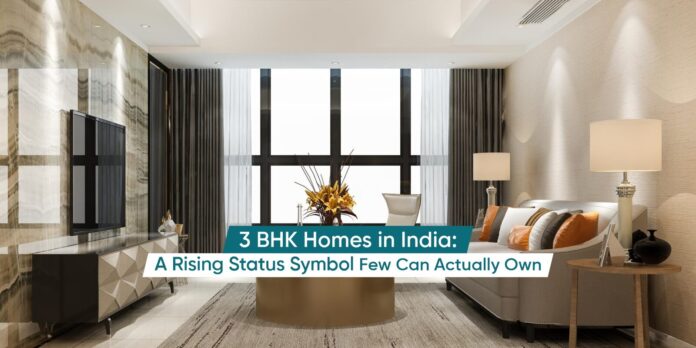The 3BHK luxury lifestyle of India clashes with harsh economic challenges that reality presents.
The Indian dream of buying a 3BHK apartment has evolved into a status indicator which provides comfort and enables social advancement in contemporary India.
The desire for luxurious 3BHK homes drives 48% of potential homebuyers yet numerous Indians must settle with 2BHK flats because of high property expenses and tight budgets.
The Allure of 3BHK
The Indian homebuyer underwent a significant mindset change since the pandemic ended.
Homebuyers used to be satisfied with 2BHK properties but now they actively seek additional rooms to establish home offices as well as areas for children to study and spaces to accommodate elderly family members. A significant increase in consumer preference toward 3BHK units occurred since H2 2023 according to FICCI ANAROCK Consumer Sentiment Survey since 50% of respondents chose 3BHK while 42% selected 2BHK from a total of 38% favoring 2BHK.
Bengaluru, Chennai, Hyderabad and Delhi-NCR demonstrate the strongest preference shift toward larger living spaces. The Mumbai residential market remains competitive but 3BHK properties continue to gain popularity among buyers while 2BHK demand remains at 44%.
Pandemic-Driven Dynamics
Online education and working from home led to an explosive increase in the need for spacious properties. The recent data shows that 3BHK properties represented 49% of new construction while taking up 44% of unsold stock in Delhi-NCR during 2022 thus replacing 2BHKs which declined from 40–45% before COVID to only 12% by that point.
Research data indicates that Tier 1 city homebuyers bought 38% more three-bedroom homes during Q3 2023 compared to 29% in Q3 2020.
Price Tag Reality Check
The desire to ascend in life meets an unyielding reality regarding financial affordability. The middle-class people of Delhi share stories about how expensive it is to fulfill their dreams. Online discussions show that the cost of a 3BHK in IP Extension reaches ₹1.8 crore while Model Town and CR Park flats sell between ₹2.5–4.5 crore but remain unaffordable to most salaried professionals.
A person on the forum stated:
Middle class workers in Delhi face an impossible challenge when trying to purchase real estate because prices are extremely high. The purchase price of well-known neighborhoods exceeded what any middle class person could afford because it required them to pay crores for a flat while giving up their ancestral home which they left behind.
The number of affordable housing units below ₹1 crore in the mid-income range in Delhi NCR has decreased significantly from approximately 310,000 units in 2022 to fewer than 200,000 units in 2024 which represents a 36% reduction.
Crunching the Numbers
The market price for an additional room in a 3BHK development exceeds the base price by 15–25%. A 2BHK unit that measures 1,000 sq ft priced at ₹8,000 per sq ft equals ₹80 lakh. A 3BHK unit that measures 1,200 sq ft costs approximately ₹96 lakh which amounts to an additional ₹16 lakh. The investment provides 30–40% higher rental income yet generates substantial monthly EMIs that limit household financial capabilities.
The advice from housing experts states that EMIs should not exceed 35–40% of monthly income to prevent financial hardship in an environment where salaries remain stagnant while home prices continue to rise.
Location Trade-offs
People who want affordable housing choose to move to outer suburbs since they cannot afford their desired locations. The demand for 3BHK homes increased in Noida and Gurugram because these areas offer improved connectivity and parks together with lower prices than central Delhi even though residents may need to commute longer distances.
The real estate market in outer suburbs and Tier 2 cities provides residents with bigger housing options along with community amenities at prices similar to their central city counterparts.
The Broader Outlook
The preference for large houses throughout India exists as an observable national trend. Real estate platforms indicate that 3BHK properties now constitute more than half of all housing requests in metros during Q1 2025 while previously they made up only 35–40% of the market before the pandemic.
The developer sector has answered this trend by launching numerous new projects that incorporate 3BHK units and luxury homes into their development plans.
A large portion of middle-class Indians faces the reality of missing out on owning their desired comfortable 3BHK homes. The rapid growth of housing prices outpaces income levels which pushes people to make sacrifices between home size and location by choosing financial stability, over EMIs they can afford and city access.
Conclusion
The 3BHK obsession reflects India’s evolving aspirations—a desire for space, status, stability, and security. But until the cost curve eases, many will remain anchored in 2BHKs, caught between the dream and economic reality. Bridging that gap may require innovative financing, targeted affordable housing schemes, and a supply-side focus on mid-income segments to bring bigger dreams within reach.



